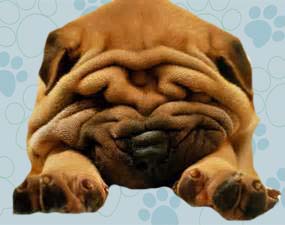Folds of Four – A little dab will do ya
December 8, 2014 – Folding sheets, socks and skivvies keeps them clean, neat and, when stored away, dry; folding skin, even by necessity… not so much. Want to create the perfect living arrangement for bacteria, yeast and the offspring of flying insects (aka maggots)? Three words… fold the skin. Folding the skin is the best way to wet it, rub it, oil it and macerate it. If you then super size it, lick it and paw it; you’ve got the pet’s version of a home for communicable diseases.
None of us could function without skin folds. Other than being a minor nuisance, a source of embarrassing odor, and the final resting place for lint, hair and residual toiletries, they’re relatively easy to manage in humans (likewise for cats). Not so for dogs; those, under the purebred pressures of human intervention, that take skin folds to a higher, more debilitating, level.
The Shar Pei is arguably the poster child of dogs with excessive skin folds, followed closely by the Bulldog, Boxer, Boston Terrier, Cocker Spaniel, Shih Tzu, Pug, Basset Hound, Dachshund and a host of others. “But they’re so ugly… they’re cute.” Cute doesn’t cut it when these dogs must contend with the perils of natural folds; complicated by the additional burden of being too big.
How do you fix folds? Obviously… remove them! Although surgery is an option for hidden folds; it’s not likely to be the first choice of those who prize those breed related mounds of puffy pleats. That leaves regular grooming, in-home maintenance, and medical management to keep folds friendly. There are four areas of the body that are particularly problematic; the ears, face, paws and bottom; all have four things in common; moisture, oil, friction and easy access; and all are managed with four simple techniques; groom the hair shorter (or at least keep it free of mats), clean with wipes, dry with powder, and treat when needed.
Bottom line: Stay free of fold faults with a finely tuned four-fold format

